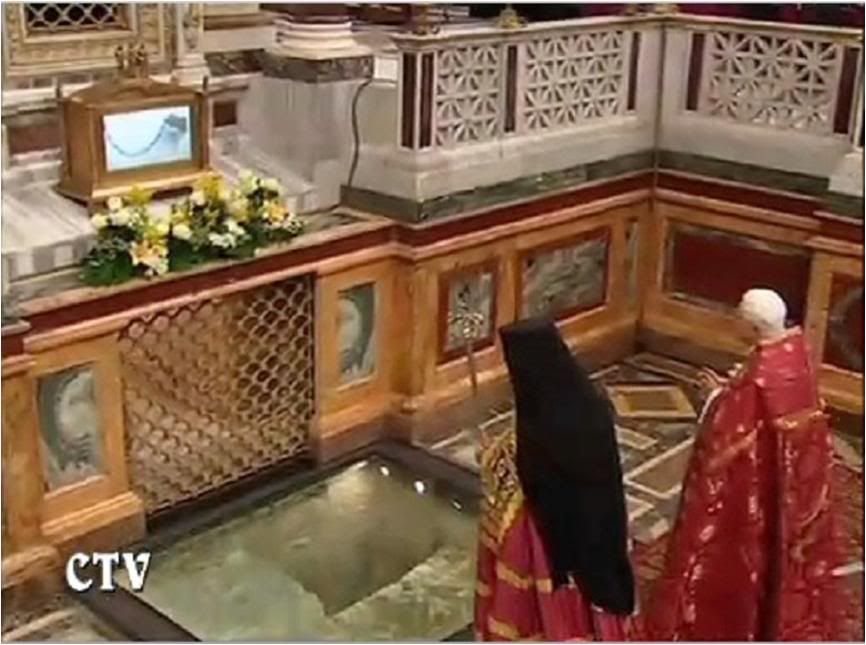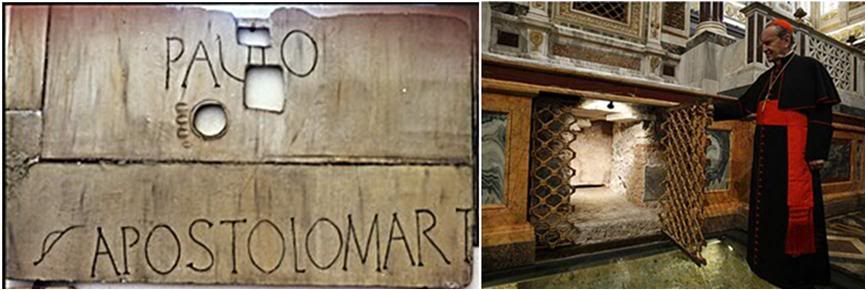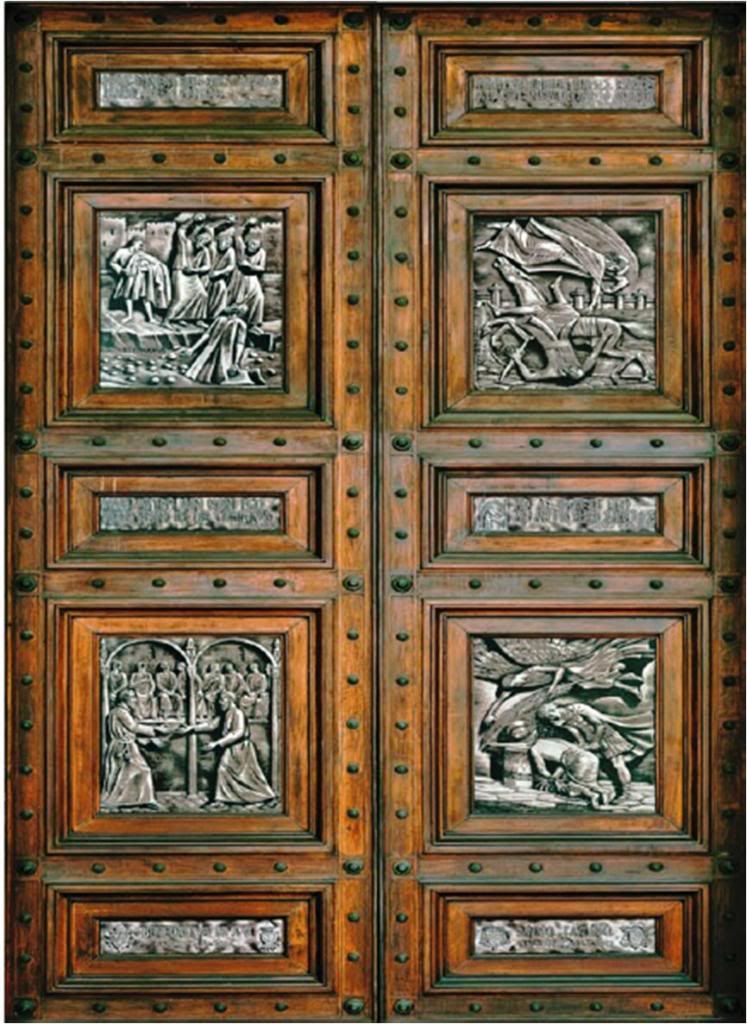
 St Paul's tomb:
St Paul's tomb:
Between history and faith -
And why Benedict XVI kept
the research under wraps
by Mario Ponzi
Translated from
the 7/3/09 issue of

"I repeat and I confirm: St. Paul's tomb has never been opened".
Cardinal Andrea Cordero Lanza di Montezemolo said this on the eve of his last news conference today as Arch-Priest of the Papal Basilica of St. Paul outside the Walls.
The news conference, he said, will have little to add to what Pope Benedict XVI announced at the Basilica on Saturday evening.
"Except for technical details about which I am not competent," he pointed out. "For this we will have the expert who executed the work materially, who can give all the details of what he did."
The cardinal expressed the hope that the news briefing would help satisfy the curiosity raised by Benedict's announcement about Carbon-14 dating of human remains found inside a tomb that has been closed for 20 centuries.
[NB: It must be noted that the cardinal, born to a noble family in Turin, was an architect by training and profession before he decided to become a priest. He has also kept up a related interest in archaeology.]
The cardinal also explains why there had been silence about the investigation before this.
"First of all, this was an announcement that had to come from the Pope himself. We also did not want to repeat what happened when the tomb of St. Peter was discovered with his bones (in 1950, under Pius XII). People got to learn about studies being made and that immediately started a controversy among archeologists".
The cardinal was referring to the diatribe particularly between Jesuit Antonio Ferrua, who doubted the identification, and the epigraphist Margherita Garducci who was positive about it. At the time, it took almost 20 years until Paul VI could declare on June 26, 1968 that "Even the relics of St. Peter have been identified in a way that we can consider convincing, and we must give thanks to those who have devoted the most careful study in this long and arduous effort".
In teh earky 1950s, it had not been possible to use a dating technique that has now become very refined: using a carbon isotope, C-14, for radiometric dating of organic material
[anything containing the element carbon in any chemical combination, such as human remains].
In any case, the cardinal also points out that 20 years ago, the premature reports in the media about Carbon-14 studies of the Shroud of Turin were in large part responsible for the continuing controversy about its dating.
He says: "When some two years ago, I proposed to the Pope the celebration of a year dedicated to St. Paul for the bimillenary of his death - which I must say the Pope immediately accepted and with great joy - I also proposed the idea of a scientific 'recognition' of the sarcophagus.
"It had been lying down there for two centuries and obviously had never been opened. Though there has been unopposed concordance through the centuries that this tomb is that of St. Paul, this had never been actually proven.
"So the Pope also agreed to an investigation, but decided that nothing should be done about it until after the end of the Pauline Year, so that pilgrims could pray at a shrine, and not at a 'work site'. Because to open the tomb itself would require not simply to temporarily move out the main altar at St. Paul but even Arnolfo da Cambio's baldachin over it."

The tomb is directly under the altar, and is enclosed in a wall of stone and brick that is almost a meter thick on all four sides.
"This was necessary protection, says the cardinal, "because in the past, whenever the Tiber flooded, the waters reached to this place and threatened the integrity of the sarcophagus - and that was why at some remote time, it was enclosed in this sort of solid fortress."
The flood threat from the Tiber has since been controlled
The cardinal explains: "In full agreement with the abbot - one must remember the papal basilica includes a Benedictine abbey - we opened a small gap in this solid wall and uncovered one of the sides of the sarcophagus itself. It is of raw Carrara marble - unworked and unpolished. We have taken it to mean that the sarcophagus had bot been decorated - it would have been chiselled and sculpted with appropriate designs. Most likely, the work was never carried out, and after being sealed in by the protective wall, it was no longer possible to do so. But there was above it a heavy stone slab on which is written 'Paulo apostolo mart'.

"In order to allow pilgrims to see the part of the tomb that has been uncovered, we had to move a small altar dedicated to St. Timothy of Antioch from the fourth century.
"It has been quite a novelty for pilgrims. Very few used to come down to the hypogeum (
underground space below the main floor). But since the time we arranged for part of the tomb to be seen by the public, many pilgrims to the basilica have gone down to pray at the tomb or simply look at the exposed part."
However, exposing part of the sarcophagus itself does not answer any questions about what it contains.
"After having consulted with experts at the Vatican Museums, I prepared a proposal to the Pope: We could drill a small hole through the slab that covers the tomb, through which a probe could be introduced.
"I don't remember the exact date but in the winter between the end of 2007 and the start of 2008, Ulrico Santamaria - a chemist who teaches science and technology of materials at the University of Tuscia, as well as director of the diagnostics laboratory for conservation and restoration at the Vatican Museums - came to drill that hole. After being sworn solemnly to secrecy.
"He used a microdrill that could be used on stone - similar to what a dentist uses - to bore a hole through the slab, through which a tiny scope equipped with light could be passed and which could 'look around' and retrieve samples.
[This would be similar to camera-equipped scopes used by surgeons to investigate inside the body with minimally invasive technique - some slender enough to be introduced into blood vessels, for instance. Some scopes have a second channel through which a controllable instrument can be inserted in order to snip, pinch or pick up material for analysis, or biopsy, when it is a surgical scope.]
"With micropincers, similar to those used in arthroscopy and microsurgery, he retrieved some samples. We had these analyzed, observing great secrecy for the reasons I stated, at a laboratory that specializes in such investigations, without revealing where the samples came from nor who the client was - so as not to influence the study in any way, and that it would be as objective and scientifically sure as it could be".
All this was done in strictest secrecy, known only to a few.
"They must have done the probe at night or when the basilica was completely deserted," said an employee whose job requires him to be aware of what is taking place below the altar. "None of us had any clue all this was taking place until the Pope revealed the findings last Sunday".
Cardinal Lanza di Montezemolo reiterated that in all this, "I always acted with the full agreement of the Pope, even when I refused to give any information to some who may have started to suspect something was going on."
"The Pope's announcement relieved me of an enormous 'weight' that I have carried for more that a year," he said. "But the few of us who knew what was happening all agreed that any announcement must come from the Pope himself."
Now, the expectations are about further studies - already done - that could lead to opening the sarcophagus itself.
"I don't foresee it happening soon," the cardinal says, "because the work it requires is enormous, and the precarious nature of the site requires extreme prudence."
The cardinal also spoke of the Porta Paolina, or Pauline Door, the third front door to the Basilica which the Pope opened at the inauguration of the Pauline Year last year.
"I had proposed to open the Holy Door for the Pauline Year, but the Pope said categorically, 'No, the Holy Door should only be opened during a Holy Year, and the Pauline Year is a thematic year, not a Holy Year'.
[Since 1900, the Church has observed an 'ordinary' Holy Year every 25 years, a year of universal pardon and reconciliation under certain conditions. 'Extraordinary' Holy Years are decreed to mark a special event - as when in 1933 and in 1953, Popes Pius XI and John Paul II, respectively, decreed a Holy Year to mark the 1900th and 1950th anniversaries of the death of Christ. The Great Jubilee Year of 2000, marking the bimillenary of the birth of Christ, was also a Holy Year, which fell at the turn of the millennium.]
"So I said we could open the third of the five front doors and call it the Pauline Door. And because of its importance, we asked sculptor Guido Veroi to decorate it appropriately with bronze reliefs.
[Veroi is a Roman artist who directed the casting of a bronze copy of the famous equestrian statue of Marcus Aurelius in the Campidoglio which was mounted there when the original marble statue had to be restored.]
The sculptor executed four pictorial panels in relief, each weighing 50 kilograms, and six scrolls - three in Latin on the left panel, and three in Greek on the right "to underscore the ecumenical significance of this basilica, and as an expression of the wish for a reunification of the Churches of the East and West".
 The reliefs show from the top, left to right: The martyrdom of St. Stephen, with the young Saul of Tarsus at left, holding the martyr's
The reliefs show from the top, left to right: The martyrdom of St. Stephen, with the young Saul of Tarsus at left, holding the martyr's
clothes; the conversion on the road to Damascus; the meeting with Peter at the Council of Jerusalem; and Paul's beheading.
Veroi's work took a year. First, it had to be verified that the door could bear the weight to be added, "but fortunately, the door is quite robust with powerful hinges - and it could well support the added weight".
The door opened by the Pope on June 28, 2008, only carried facsimiles of the reliefs, but last Sunday, "he was able to admire the completed work".
The cardinal officially closed the Pauline Door symbolically the day after the closing Vespers presided by the Pope, thus officially closing the Pauline Year".
"Closed but not concluded," tho cardinal says. "And actually, the Pauline Door will continue to be opened every day as a fitting 'welcome' from teh Apostle to his 'peoples' [In Italian, the word for Gentiles, 'genti', also means 'peoples'.]
 A report on the news briefing that was held yesterday (7/3/09):
Officials discuss the studies
A report on the news briefing that was held yesterday (7/3/09):
Officials discuss the studies
done so far on Paul's tomb:
Findings concur with tradition

ROME, JULY 3, 2009 (Zenit.org).- Investigation into the tomb held to be St. Paul's does not confirm that it is in fact the Apostle who is buried there, but it also does not contradict that tradition, Vatican officials noted.
Cardinal Andrea Cordero Lanza di Montezemolo, archpriest of the Basilica of St. Paul Outside the Walls, and Ulderico Santamaria, director of the diagnostic laboratory for the conservation and restoration of the Vatican Museums, discussed the investigations during a press conference today.
Benedict XVI had asked that the results of the research would not be announced until the close of the Pauline Jubilee Year, which ended last Monday. The Holy Father himself was the first to divulge the findings, during his homily at the Vespers service that brought the jubilee to an end.
The Pope explained: "A tiny hole was drilled in the sarcophagus, which in so many centuries had never been opened, in order to insert a special probe which revealed traces of a precious purple-colored linen fabric, with a design in gold leaf, and a blue fabric with linen threads. Grains of red incense, as well as protein and calcium substances were also found. In addition, minute fragments of bone were sent for carbon-14 testing by experts unaware of their provenance. The fragments proved to belong to someone who had lived between the first and second centuries. This would seem to confirm the unanimous and undisputed tradition which claims that these are the mortal remains of the Apostle Paul."
Cardinal Cordero Lanza di Montezemolo classifed the results as "not only interesting but also [results] that mesh with" what is believed about the location of Paul's remains.
The cardinal, whose retirement as archpriest of the basilica for reasons of age was also announced today
(he turns 84 in August, but was kept on in his position by Benedict XVI because of the Pauline Year), indicated that further investigations could be a possibility in the future.
He noted that to actually open the sarcophagus will be difficult, because it will require dismantling the papal altar on top.
For his part, Santamaria explained how the technique of drilling into the sarcophagus "reduced to a minimum [...] the risks of deteriorating the interior by preventing any oxygen from getting into the tomb."
[Modificato da TERESA BENEDETTA 15/07/2009 21:44]